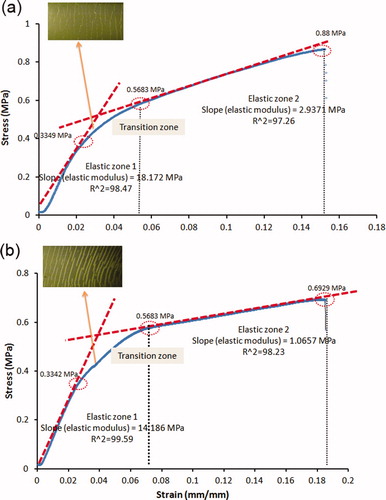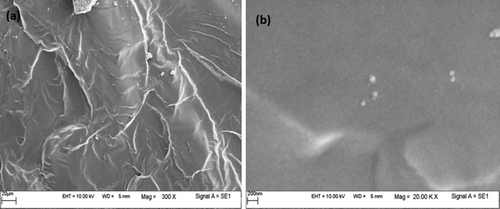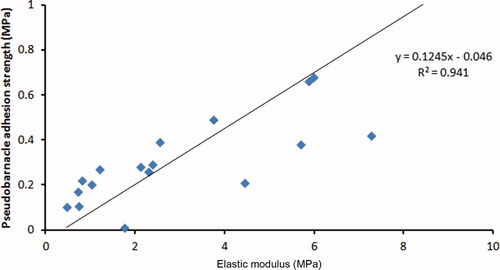Abstract
A series of poly(dimethyl siloxane) (PDMS)/silica nanocomposites were synthesized utilizing a sol gel method. The samples were evaluated using pseudobarnacle adhesion and tensile strength tests. The effects of the molecular weight of the PDMS and the size and structure of the silica domains on biofouling release and the mechanical behavior of the PDMS/silica materials were investigated. Three different molecular weights (18,000, 49,000 and 79,000 g mol−1) of hydroxyl-terminated PDMS (HT-PDMS) were used to prepare the nanocomposites with three different weight ratios (1:1, 3:1 and 5:1) of HT-PDMS to tetraethyl orthosilicate (TEOS). TEOS served as a crosslinker to form PDMS networks and as a precursor to form silica domains. Two different variants of TEOS with regard to its degree of polymerization (n) (monomeric type: n ≅ 1 and oligomeric type: n ≅ 5) were used for in situ formation of silica particles via the sol-gel process. The mechanical properties of the composites were characterized using stress–strain isotherms. All the mechanical properties evaluated (Young's modulus, tensile strength, energy required for rupture, elongation at break) improved with increases in the molecular weight of the HT-PDMS and the silica content. The pseudobarnacle adhesion test was used to examine the fouling- release (FR) properties of coatings applied on aluminum plates. The rupture energy and tensile strength increased substantially when oligomeric TEOS was employed in the PDMS/silica composites. Scanning electron microscopy (SEM) was used to investigate the structure of the silica domains. It was found that the use of oligomeric TEOS in higher molecular weight PDMS samples with higher PDMS/TEOS weight ratios led to low pseudobarnacle adhesion strengths of ∼0.3 MPa, which is in the range of commercial FR coatings.
Introduction
Biofouling is ubiquitous in the marine environment. This fouling that clings to the hulls of ships results in increased operational and maintenance costs by increasing the fuel consumption and frequency of dry-docking operations (Callow Citation1990; Townsin Citation2003; Yebra et al. 2004; Schultz et al. Citation2011). Toxic antifouling paints containing copper, tin and other biocides have been applied to ships to combat fouling (Rascio Citation2000; Thomas and Brooks Citation2010) until the use of tin-based paints was banned by environmental organizations (Champ Citation2000; Dafforn et al. Citation2011). This legislation led to the development of fouling-release (FR) coatings as an alternative nontoxic technology (Brady et al. Citation1987; Brady Citation1994, Citation1997, Citation2000; Adkins et al. Citation1996). Although organisms can attach to these coatings, they are removed by either mechanical or forceful water movement, which is caused by the motion of the vessel (Swain and Schultz Citation1996; Kavanagh et al. Citation2005).
Initially, both silicones and fluoropolymers were identified as FR surfaces because both polymers exhibit low critical surface tension and this character is considered crucial for foul releasing ability (Baier and Meyer 1992; Callow and Fletcher Citation1994). Baier and Depalma (1971) studied the relationship between the critical surface tension of the polymer surface and the relative amount of bioadhesion. The results were shown as the “Baier curve.” An important feature of this curve is that the minimum in bioadhesion does not occur at the lowest critical surface energy. The minimum of the Baier curve is attributed to poly(dimethylsiloxane), which has a very low elastic modulus (0.002 GPa). Later, it was found that the FR behavior of polymers depends not only on the surface energy but also upon mechanical properties such as the elastic modulus (Brady and Singer Citation2000; Singer and Kohl Citation2000; Brady Citation2001). Because of this, silicone polymers outperformed fluoropolymers (Brady Citation1999). Furthermore, fluoropolymers are porous, thus they allow fouling organisms to establish a mechanical interlock. The superior properties of silicones also have been attributed to the low glass transition temperature of silicones that is reflected in their molecular mobility (Bausch and Tonge Citation1996; Brady Citation1997). Interfacial slippage and friction also play a role in enhancement of the release properties of silicones compared to fluoropolymers (Newby et al. Citation1995; Newby and Chaudhury Citation1997).
Commercially available FR coatings are based on silicone elastomers formed from polymerized dimethylsiloxanes (PDMS) (Yebra et al. 2004). Poly(dimethylsiloxane) elastomers are inherently weak materials and exhibit very poor mechanical properties (Dewimillea et al. Citation2005). Therefore, they may not be durable enough to survive on a ship's hull. Because of their poor mechanical strength, there is a great need to improve the mechanical properties of PDMS-based FR coatings. Griffith (Citation1995) introduced a duplex silicone coating that is considerably tougher than a single layer coating. A silicone duplex or bi-layer elastomeric coating consists of a low-modulus silicone top layer bonded to a substratum by the use of a stiffer silicone bond coat, which is blended with copolymers such as butyl acrylate styrene (Kohl and Bolstes Citation2001). Although the bond coat is responsible for bonding to a substratum and providing mechanical strength, many attempts have been made to enhance the mechanical properties of the silicone top coat. Some studies (Yuan and Mark 1999; Mirabedini Citation2008; Fang et al. Citation2010; Rath et al. Citation2010) have been carried out to alleviate the durability problems of PDMS-based coatings. Due to the good mechanical properties of the cured epoxy resin materials, Rath et al. (Citation2010) employed epoxy resin to modify PDMS-based FR coatings. They investigated the effect of modulus and surface energy on pseudobarnacle and macrofouling behavior. But pseudobarnacle tests revealed that the release force increased significantly by using epoxy. Incorporation of polyurea segments to the PDMS backbone is another way for reinforcing PDMS (Fang et al. Citation2010). The extent of phase separation with the extensively hard domains created an interconnected network that imparted mechanical rigidity.
In addition to blending PDMS with other polymers, some studies (Mark Citation1996, Citation1999; Dewimillea et al. Citation2005; Paul and Mark Citation2010) have shown that incorporation of filler particles (usually silica) into the soft matrix has a profound effect on mechanical properties. Silica can be used for reinforcing PDMS in two ways. In the first conventional method, particulate silica particles are blended into the PDMS before cross-linking (Sun and Mark Citation1989). However, this type of ex situ blending process is difficult, time consuming and energy intensive (Yuan and Mark 1999). An alternative technique, which was used for the study reported here, is a sol–gel method that was introduced by Mark et al. (Citation1984). In this method, hydroxyl-terminated PDMS chains are blended with enough tetraethyl orthosilicate to simultaneously end-link the PDMS chains and produce the silica particles (Mark et al. Citation1984; Dewimillea et al.2005; Alexandru et al. Citation2009). Mark et al. (Citation1984) investigated the mechanical properties of such in situ networks and showed that increasing the silica content generated in situ leads to an increased elastic modulus, but there is a tradeoff between FR properties and mechanical durability. Although the best mechanical performance has been seen with harder coatings, the best FR properties are obtained with softer materials (Stein et al. Citation2003a, Citation2003b; Perera Citation2004; Mirabedini et al. Citation2008).
With FR coatings, the most important point that must be considered is that increasing the elastic modulus may have deleterious effect on the FR property. Finding a solution to this problem is one of the greatest challenges faced by scientists today. Therefore, there is a great need to adopt a new approach to this challenge. All strategies mentioned above for reinforcing PDMS adversely affect FR behavior. This paper makes the suggestion of using oligomeric (instead of monomeric) ethyl silicate in order to have good mechanical durability, in addition to acceptable FR. The present investigation extends the studies referred to by employing oligomeric ethyl silicate (partially hydrolyzed ethyl silicate), as well as the monomeric form, and 3 different molecular weights of hydroxyl-terminated PDMS (low, moderate, and high molecular weights). The mechanical properties of the PDMS/silica nanocomposites were examined by analyzing the tensile strength, elongation at break, Young's modulus, and the energy required for rupture. In addition, scanning electron microscopy was employed to study the structure of the silica domains generated in situ. FR was measured by the pseudobarnacle adhesion test to determine the effect of oligomeric ethyl silicate on the FR coatings.
Materials and methods
Materials
Hydroxyl-terminated PDMS with number average molecular weight of 18, 49 and 79 (×103 g mol−1) were obtained from Bluestar Silicones (France). Either TES 28 (a monomeric TEOS) or TES 40 (a partially hydrolyzed form TEOS), were used as the crosslinking agent for the formation of the PDMS network and also as the precursor for the in situ formation of silica. TEOS materials were obtained from Wacker Corporation (Germany). The catalyst, dibutyltindiacetate (DBTDA) and xylene were purchased from Merck (Germany). All of these chemicals were used as received without further purification.
Sample preparation
According to Scheme 1, a series of PDMS/silica nanocomposites was prepared from three different molecular weights of HT-PDMS (18, 49 and 79 (×103 g mol−1) and two TEOS materials for the end-linking of HT-PDMS and the forming of silica domains. The crosslinking agent was mixed with HT-PDMS in three weight ratios (1:1, 1:3 and 1:5). presents the information on the prepared PDMS/silica nanocomposites. Sample designations indicate the form of TEOS used (TES 28 or TES 40), the PDMS/TEOS weight ratio (1, 3, or 5), and the PDMS molecular weight (18, 49, or 79 × 103 g mol−1); eg 28-1-18 designates TES 28, a 1:1 PDMS/TEOS weight ratio, and an initial PDMS molecular weight of 18,000 g mol−1.
Table 1. Synthesis information and composition of the nanocomposites.
In the general procedure, TEOS and HT-PDMS were mixed together and then 40 wt% xylene was added to the mixture. The resulting mixture was stirred for 20 min at room temperature until it became homogeneous. Then, 1% (w/w) of catalyst (DBTDA), based upon the total weight of the composition, was added to the mixture. Afterwards, the mixture was poured into rectangular Teflon molds (100×40×1 mm) to prepare free films with film thickness of less than 1 mm. For pseudobarnacle adhesion measurements, a part of each mixture was applied on sanded and degreased aluminum plates (150×100 mm) by a manual film applicator. The thickness of dry films on the aluminum plates was 175 (±25) μm.
The curing reaction was allowed to proceed at room temperature and 50% relative humidity for 3 days. The water required for the hydrolysis of the TEOS was generally absorbed from the humidity in the air. Finally, the film was vacuum-dried to constant weight in order to remove the byproduct C2H5OH and unreacted TEOS.
Characterization techniques
Mechanical properties
The stress–strain isotherms were obtained using a Santam tester. Modulus, tensile strength, elongation and rupture energy were derived from these isotherms. Samples of dimensions 100×40×1 mm were pulled to rupture at a rate of 50 mm min−1 using the procedure defined by ASTM Standard D 412 (2006). Eighteen different samples were prepared for tensile testing (). The values reported for elastic modulus, tensile strength, elongation and rupture energy are the average of five replicates of each of the 18 samples.
Scanning electron microscopy (SEM)
The SEM images of fractured surfaces of PDMS/silica films were obtained using a LEO 1455VP instrument.
Pseudobarnacle adhesion test
Pseudobarnacle adhesion measurements were performed on samples using ASTM D5618 (2011). Wooden studs of known diameter were glued (epoxy adhesive) to the surface of coatings on the aluminum plates. The adhesive was allowed to harden for 3 days under ambient condition before testing. After that, the shear force required for removing each stud was measured using a force gauge. The force gauge was mounted on a surface, as can be seen in ; the coated plates were moved parallel to the force gauge. The velocity of the moving plate has no effect on pseudobarnacle adhesion strength (Stein et al. Citation2003a).
Results and discussion
Mechanical properties
In order to determine the effect of incorporating oligomeric TEOS (TES 40) as a crosslinking agent on reinforcement of PDMS elastomers, the mechanical properties of PDMS/silica nanocomposites prepared using different molecular weights of PDMS and PDMS/TEOS weight ratios were investigated and compared to the mechanical properties of samples prepared with the monomeric TEOS (TES 28). The average values for 5 replicates of each sample are given in . and , respectively, show the elastic modulus and tensile strength of the in situ silica-filled PDMS samples. According to the data, the increase in the silica content lead to an increase in modulus, which results from the inclusion of rigid particles in the soft matrix. This trend can be seen in all samples of three different molecular weights of PDMS without considering the type of TEOS. The results show that samples prepared with the oligomeric TEOS were stiffer than those synthesized by monomeric TEOS in three different molecular weights of PDMS. This would be attributed to difference in the weight percentages of silica precipitated in the both oligomeric and monomeric TEOS cured samples. TES 40 (the oligomeric type) is an ethyl silicate providing approximately 41wt% of silicon dioxide (silica) upon complete hydrolysis whereas TES 28 (the monomeric type) contains 28.5wt% silica after being completely hydrolyzed.
Figure 2. The effect of silica content and TEOS type on the elastic modulus of PDMS/silica nanocomposites with molecular weights of (a) 18,000, (b) 49,000 and (c) 79,000 g mol−1.
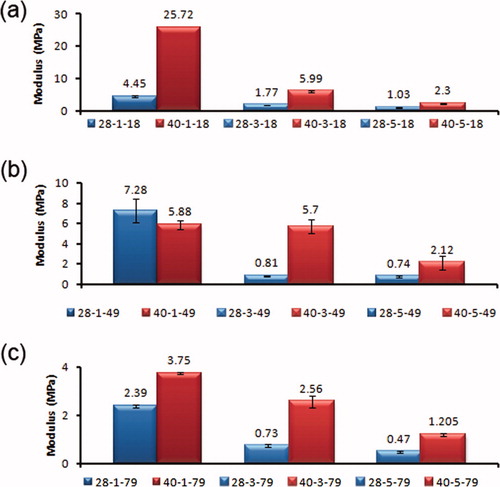
Figure 3. The effect of oligomeric TEOS on the tensile strength of PDMS/silica nanocomposites with molecular weights of (a) 18,000, (b) 49,000 and (c) 79,000 g mol−1.
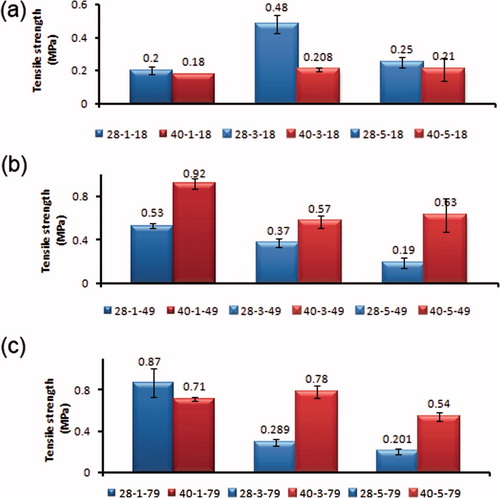
Table 2. Mechanical properties of the nanocomposites.
With respect to the weight ratio of PDMS to TEOS, in the monomeric TEOS-cured samples, the silica content ranged from 5% to 20%; while in the oligomeric samples, it ranged between 9% and 29% (). Although the oligomeric TEOS-cured composites had higher moduli than the monomeric samples, some of them (such as 40-5-79, 40-3-79, 40-5-49 and 40-5-18) had elastic moduli of ∼2 MPa, which is an acceptable value for the FR coatings. As already mentioned, the low elastic modulus of the PDMS had a profound effect on decreasing the bioadhesion strength. The samples with suitable low elastic moduli, prepared by the oligomeric TEOS, should be enough on a ship's hull to provide mechanical durability and FR.
The tensile strength values of the samples are shown in . The important point to make is that the oligomeric TEOS had two completely different effects on tensile strength in high- and low-molecular weights PDMS. As can be seen in , the incorporation of oligomeric TEOS at different weight ratios of PDMS to TEOS lead to improvement in the tensile strength values with PDMS having molecular weights of 49,000 g mol−1 and 79,000 g mol−1. However, the oligomeric TEOS-cured samples prepared with PDMS having a molecular weight of 18,000 g mol−1 showed lower tensile strengths than the monomeric-cured samples. These results emphasize the effect of the molecular weight of PDMS on the mechanical properties of oligomeric TEOS-cured samples.
The elongation and rupture energy values of PDMS/silica samples prepared by the oligomeric TEOS are given in . As can be seen, with increasing molecular weight of PDMS, the elongation and rupture energy values of the samples increased. This trend can be seen in the all three PDMS/TEOS weight ratios (1:1, 3:1 and 5:1). Moreover, very low elongation and rupture energy values for the oligomeric TEOS-cured samples prepared with PDMS having a molecular weight of 18,000 g mol−1 demonstrate that the oligomeric TEOS made these samples brittle. However, the samples based on PDMS with a molecular weight of 79,000 g mol−1 had higher rupture energies and would be tougher compared to the other samples.
Table 3. The effect of the molecular weight of PDMS on elongation and rupture energy values of samples prepared using TES 40 in three different PDMS/TEOS weight ratios.
On the other hand, analysis of the stress–strain isotherms revealed another interesting effect of oligomeric TEOS on the mechanical behavior of PDMS/silica composites. As seen in , among all PDMS/silica composites, samples 40-1-49 and 40-1-79 showed an unusual behavior. The stress–strain isotherms of these samples show an anomalous decrease in the modulus at higher stress values. However, sample 40-1-18 showed normal behavior and ruptured at very low stress.
Figure 4. The stress–strain isotherm of PDMS/silica samples prepared with PDMS having molecular weights of (a) 18,000, (b) 49,000 and (c) 79,000 g mol−1.

The differences observed in mechanical behavior of the oligomeric TEOS-cured composites encouraged probing more deeply into the effects of the molecular weight of PDMS. This different mechanical behavior of the samples prepared by low and high molecular weight PDMS would probably be due to the difference in the nature of the network and the cross linking density. Schematic structural models of the oligomeric TEOS-cured samples with low and high molecular weights of PDMS are proposed in . In the networks having a low molecular weight, oligomeric TES 40 can lead to network rupture because of the low elasticity and poor mechanical strength of the samples. But at the higher molecular weight, the networks can resist rupturing because of high elasticity; meanwhile, as the stress increases there is a corresponding decrease in the elastic modulus.
Figure 5. Schematic structural models of the oligomeric TEOS based networks with (a) a low molecular weight of PDMS and (b) a high molecular weight of PDMS.
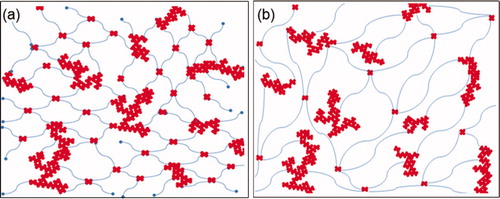
At the weight ratio of PDMS/TEOS of 1:1 (high silica content), if oligomeric TEOS is used to crosslink PDMS with high molecular weight, heterogeneity in the samples is enhanced. This heterogeneity is caused by the phase separation of the micron-sized rigid silica networks and the PDMS elastomer network. Under low applied stress and low strain, the mechanical behavior of oligomeric TEOS-cured PDMS elastomers are dominated by the silica domains as hard inclusions in a soft matrix. With increasing stress/strain and interruption of the silica domains, the elastomeric network of PDMS will control the mechanical behavior of composites. The samples 40-1-49 and 40-1-79 at the first elastic zone show high modulus values of 18.17 MPa and 14.19 MPa, respectively. As can be seen in a and 6b, at the first elastic zone, cracks appeared on these two samples, indicating the role played by the silica domains. With applied stress, the micron-sized silica domains are broken. It is interesting that the transition zone for both samples occurred at a stress range between 0.33 MPa and 0.57 MPa. At the second elastic zone, samples 40-1-49 and 40-1-79 showed low modulus values of 2.94 MPa and 1.07 MPa, respectively (a and 6b).
Scanning electron microscopy
SEM was used to investigate the structure of the silica domains in order to explain the different properties of samples based on the oligomeric tetraethyl orthosilicate. and show SEM images of the composites prepared by monomeric and oligomeric TEOS, respectively.
PDMS/silica nanocomposites have a very complex morphology extending from several nanometers to hundreds of microns (Schaefer et al. Citation2000, Citation2002; Schaefer and Mark Citation2001). SEM was used to identify the large-scale structure of the silica domains. It can be seen that silica domains in the oligomeric TEOS-cured sample () were larger than those of the monomeric-cured sample (). In b, the silica domains generated by monomeric TEOS are not easily visible at the scale of 200nm. However, in b, those generated by oligomeric TEOS can be seen to be >1 μm in size. The different large-scale structure of the silica domains in monomeric and oligomeric TEOS-cured samples apparently led to different mechanical behaviors. The phase separation of micron-sized silica domains and PDMS chains, which occurred in the 40-1-49 sample, would be a reason for the unusual stress–strain behavior of the oligomeric TEOS-cured samples with high molecular weight PDMS.
Pseudobarnacle adhesion measurements
In order to quantify the potential effect of oligomeric TEOS on organismal detachment strength, the pseudobarnacle adhesion strengths of PDMS/silica nanocomposites were measured. The pseudobarnacle adhesion values were obtained rather than barnacle adhesion values in order to decrease the standard error and experimental time in measurements. Swain et al. (Citation1997) showed that, over large ranges in fouling adhesion, an excellent correlation existed between pseudobarnacle adhesion strength and barnacle adhesion strength for silicone coatings.
The pseudobarnacle adhesion values of the samples prepared with PDMS having molecular weight of 18,000 g mol−1 increased using the oligomeric TEOS (). According to a, the stress required to remove studs glued on sample 28-3-18 was much lower (ie 0.008 MPa) than sample 40-3-18 (ie 0.68 MPa). Moreover, with an increased load of oligomeric TEOS (ie a decreased PDMS/TEOS weight ratio), pseudobarnacle adhesion strength increased. The pseudobarnacle adhesion strengths of the nanocomposites prepared with PDMS having molecular weights of 49 and 79×103 g mol−1 also increased by employing the oligomeric TEOS in comparison with monomeric TEOS. In addition, as can be seen in b and 9c, both the monomeric and oligomeric TEOS cured samples showed an increasing trend in adhesion strength with the increasing silica loading. By changing the weight ratio of PDMS/TEOS from 5:1 to 1:1, the corresponding adhesion values increased 300% and 135%, respectively, for the monomeric and oligomeric TEOS-cured samples prepared with PDMS having molecular weight of 49,000 g mol−1.
Figure 9. The effect of silica content and TEOS type on the pseudobarnacle adhesion strength of PDMS/silica nanocomposites with molecular weights of (a) 18,000, (b) 49,000 and (c) 79000 g mol−1.
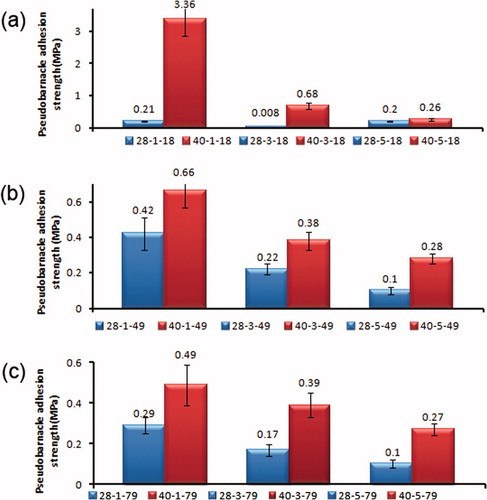
As already mentioned, the low elastic modulus of silicone coatings is known as an important factor that contributes to their efficacy as FR surfaces. Traditionally, FR behavior has been associated with low surface energy (Callow and Fletcher Citation1994). However, a more complete model of FR behavior requires the fracture mechanics approach, as demonstrated by Kendall (Citation1971) who showed that the release behavior of elastomers depends not only on the surface energy, but also upon mechanical properties such as the modulus of elasticity and, for coatings, the thickness. The pseudobarnacle adhesion values were plotted vs elastic modulus for all prepared PDMS/silica nanocomposites (). The force needed to remove pseudobarnacles was shown to increase as the elastic modulus increased. As the data indicate, the pseudobarnacle adhesion strength and the elastic modulus correlated with an R-squared value of 0.94. Because the thickness of the specimens was essentially the same for all coatings, the less than ideal value of the least square may be due to differences in surface properties.
Scheme 1. The investigating parameters for studying the mechanical properties and FR behavior of PDMS/silica nanocomposites.
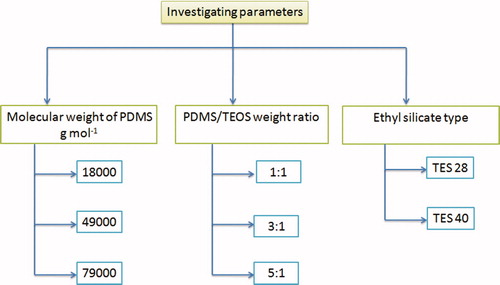
Because of an inverse correlation between FR performance and mechanical properties, it is necessary to consider the optimum properties to achieve efficient FR coating with the highest durability. Therefore, in order to study the effect of type and the amount of TEOS on FR coatings, the pseudobarnacle adhesion strength must be considered as well as the mechanical properties. It has been shown that the rupture energy and the tensile strength have been improved substantially by employing the oligomeric TEOS in the composites prepared with PDMS having molecular weights of 49 and 79×103 g mol−1. But the adhesion values of oligomeric TEOS-based samples are generally higher than the monomeric TEOS-based samples because of higher elastic modulus. However, some of the oligomeric TEOS-cured samples such as 40-5-79, 40-3-79, 40-3-49 and 40-5-49 have pseudobarnacle adhesion values of ∼0.3 MPa which is in the range of commercial FR coatings. As a consequence, the oligomeric TEOS can be used as a crosslinking and filling agent in PDMS-based FR coatings to improve mechanical durability, besides having acceptable FR performance.
Conclusions
The mechanical properties, morphology and FR properties of PDMS/silica nanocomposites were investigated. Regardless of the molecular weight of the PDMS, the moduli of both monomeric and oligomeric TEOS-based samples increased with increasing silica loading. In all, the samples prepared using oligomeric TEOS had higher moduli than the samples prepared with monomeric TEOS. In addition, the incorporation of oligomeric TEOS showed two completely different effects on the mechanical behavior of the nanocomposites in high and low molecular weight PDMS. It was seen that the rupture energies and the tensile strengths of the oligomeric TEOS-cured samples prepared with PDMS having molecular weights of 49 and 79×103 g mol−1, was substantially improved (increased). According to SEM images, the different large scale structure of silica domains in the monomeric and oligomeric TEOS-cured samples may contribute to the different mechanical behaviors.
According to the pseudobarnacle adhesion measurements, the adhesion strength of studs glued on the oligomeric TEOS-cured samples was generally higher than that of the adhesion to monomeric-cured samples because of the higher elastic moduli of the former. However, some of the oligomeric TEOS-cured samples such as 40-5-79, 40-3-79, 40-3-49 and 40-5-49 showed an acceptable pseudobarnacle adhesion value of ∼0.3 MPa. As a consequence, the oligomeric tetraethyl orthosilicate can be considered as a crosslinking and filling agent in PDMS-based FR coatings.
Acknowledgements
The authors would like to acknowledge with gratitude the PARS PAMCHAL CHEMICAL CO. who kindly supported this work financially.
References
- Adkins , JD , Mera , AE , Roe-Short , ME , Pawlikowski , GT and Brady , FR . 1996 . Novel nontoxic coatings designed to resist marine fouling . Prog Org Coat , 29 : 1 – 5 .
- Alexandru , M , Cristea , M , Cazacu , M , Loanid , A and Simionescu , BC . 2009 . Composite materials based on poly dimethylsiloxane and in situ generated silica by using the sol-gel technique . Polym Composite , 30 : 751 – 759 .
- 2006 . Standard test methods for vulcanized rubber and thermoplastic elastomers – tension. West Conshohocken (PA): ASTM International. DOI: 10.1520/D0412-06AE02 . ae2
- 2011 . Standard test method for measurement of barnacle adhesion strength in shear. West Conshohocken (PA): ASTM International. DOI: 10.1520/D5618-94R11 .
- Baier , RE and Depalma , VA . 1971 . “ The relation of the internal surface of grafts thrombosis ” . In Management of occlusive arterial disease , Edited by: Dale , WA . Chicago , IL : Yearbook Medical Publishers. p. 147–163 .
- Baier , RE and Meyer , AE . 1992 . Surface analysis of fouling resistant marine coatings . Biofouling , 6 : 165 – 180 .
- Bausch , GG and Tonge , JS . 1996 . Silicone technology for fouling release coating system . Proc Waterborne High Solids Powder Coat Symp, New Orleans (LA). Hattiesburg (MS): The University of Southern Mississippi. p. 340–353 ,
- Brady , RF . 1994 . Coming to an un-sticky end . Nature , 368 : 16 – 17 .
- Brady , RF . 1997 . In search of non-stick coatings . Chem Ind Lond , 6 : 219 – 222 .
- Brady , RF . 1999 . Properties which influence marine fouling resistance in polymers containing silicon and flourine . Prog Org Coat , 35 : 31 – 35 .
- Brady , RF . 2000 . Clean hulls without poisons: devising and testing nontoxic marine coatings . J Coat Technol , 72 : 47 – 56 .
- Brady , RF . 2001 . A fracture mechanical analysis of fouling release from non toxic antifouling coatings . Prog Org Coat , 43 : 188 – 192 .
- Brady , RF and Singer , IL . 2000 . Mechanical factors favoring release from fouling release coatings . Biofouling , 15 : 73 – 81 .
- Brady , RF , Griffith , JR , Love , KS and Field , DE . 1987 . Nontoxic alternatives to antifouling paints . J Coat Technol , 59 : 113 – 119 .
- Callow , M . 1990 . Shipfoulings: problems and solutions . Ind Eng Chem Res , 5 : 123 – 127 .
- Callow , ME and Fletcher , RL . 1994 . The influence of low surface energy materials on bio adhesion-review . Int J Biodeterior Biodegr , 133 : 333 – 348 .
- Champ , MA . 2000 . A review of organotin regulatory strategies pending actions related costs and benefits . Sci Total Environ , 258 : 21 – 71 .
- Dafforn , KA , Lewis , JA and Johnston , EL . 2011 . Antifouling strategies: history and regulation, ecological impacts and mitigation . Mar Pollut Bull , 62 : 453 – 465 .
- Dewimillea , L , Bressonb , B and Bokobzaa , L . 2005 . Synthesis, structure and morphology of poly (dimethylsiloxane) networks filled with in situ generated silica particles . Polymer , 46 : 4135 – 4143 .
- Fang , J , Kelarakis , A , Wang , D , Giannelis , EP , Finlay , JA , Callow , ME and Callow , JA . 2010 . Fouling release nano structured coatings based on PDMS-polyurea segmented copolymers . Polymer , 51 : 2636 – 2642 .
- Griffith , JR . 1995 . US Patent No. 5,449,553
- Kavanagh , CJ , Quinn , RD and Swain , GW . 2005 . Observation of barnacle detachment from silicones using high-speed video . Adhesion , 81 : 843 – 848 .
- Kendall , K . 1971 . The adhesion and surface energy of elastic solids . J Phys D Appl Phys , 4 : 1186 – 1195 .
- Kohl , JG and Bolstes , RN . 2001 . A study on the elastic modulus of silicone duplex or bi-layer coatings using micro-indentation . Prog Org Coat , 41 : 135 – 141 .
- Mark , JE . 1996 . Ceramic-Reinforced polymers and polymer-modified ceramics . Polymer Eng Sci , 36 : 2905 – 2920 .
- Mark , JE . 1999 . Ceramic modified elastomers . Curr Opinion Solid State Mater Sci , 4 : 565 – 570 .
- Mark , JE , Jiang , CY and Tang , MY . 1984 . Simultaneous curing and filling of elastomers . Macromolecules , 17 : 647 – 653 .
- Mirabedini , SM , Mohseni , M , PazokiFard , SH and Esfandeh , M . 2008 . Effect of TiO2 on the mechanical and adhesion properties of RTV silicone elastomer coatings . Colloids Surf A , 317 : 80 – 86 .
- Newby , BM and Chaudhury , MK . 1997 . Effect of interfacial slippage on viscoelastic adhesion . Langmuir , 13 : 1805 – 1809 .
- Newby , BM , Chaudhury , MK and Brown , HR . 1995 . Macroscopic evidence of the effect of interfacial slippage on adhesion . Science , 269 : 1407 – 1409 .
- Paul , D and Mark , JE . 2010 . Fillers for polysiloxane (“silicone”) elastomers . Prog Poly Sci , 35 : 893 – 901 .
- Perera , DY . 2004 . Effect of pigmentation on organic coating characteristics . Prog Org Coat , 50 : 247 – 262 .
- Rascio , V . 2000 . Antifouling coatings: where do we go from here . Corrosion Rev , 18 : 133 – 154 .
- Rath , SK , Chavan , JG , SavitaSasane , Jagannath , Patri , M , Samui , AB and Chakraborty , BC . 2010 . Two component silicone modified epoxy foul release coatings: effect of modulus, surface energy and surface restructuring on pseudobarnacle and macro fouling behavior . Appl Surf Sci , 25 : 2440 – 2446 .
- Schaefer , DW and Mark , JE . The effect of interphase coupling on the structure and mechanical properties of silica-siloxane composites . Paper presented at .
- Schaefer , DW , Suryawanish , C , Pakdel , P , Ilavsky , J and Jemian , PR . 2002 . Challenges and opportunities in complex materials: silica-reinforced elastomers . Physica A , 314 : 686 – 695 .
- Schaefer , DW , Rieker , T , Agamalian , M , Lin , JS , Fischer , D , Sukumaran , S , Chen , C , Beaucage , G , Herd , C and Ivie , J . 2000 . Multilevel structure of reinforcing silica and carbon . J Appl Crystallogr , 33 : 587 – 591 .
- Schultz , MP , Bendick , JA , Holm , ER and Hertel , WM . 2011 . Economic impact of biofouling on a naval surface ship . Biofouling , 27 : 87 – 98 .
- Singer , IL and Kohl , JG . 2000 . Mechanical aspects of silicone coatings for hard foulant controls . Biofouling , 16 : 301 – 309 .
- Stein , J , Truby , K , Wood , CD , Stein , J , Gardner , M , Swain , G , Kavanagh , C , Kovach , B , Schultz , M Wiebe , D . 2003a . Silicone foul release coatings: effect of the interaction of oil and coating functions on the magnitude of macro fouling attachment strengths . Biofouling , 19 : 71 – 82 .
- Stein , J , Truby , K , Wood , CD , Takemori , M , Vallance , M , Swain , G , Kavanagh , C , Kovach , B , Schultz , M Wiebe , D . 2003b . Structure–property relationships of silicone biofouling-release coatings: effect of silicone network architecture on pseudobarnacle attachment strengths . Biofouling , 19 : 87 – 94 .
- Sun , C and Mark , JE . 1989 . Comparisons among the reinforcing effects provided by various silica based fillers in siloxane elastomers . Polymer , 30 : 104 – 106 .
- Swain , GW and Schultz , MP . 1996 . The testing and evaluation of non-toxic antifouling coatings . Biofouling , 10 : 187 – 197 .
- Swain , GW , Schultz , MP , Griffith , J and Snyder , S . The relationship between barnacle and pseudobarnacle adhesion measurements as a method to quantify the foul release properties of silicones . Proceedings of Emerging Nonmetallic Materials for the Marine Environment . pp. 60 – 69 . Arlington (VA) : US Office of Naval Research .
- Thomas , KV and Brooks , S . 2010 . The environmental fate and effects of antifouling paint biocides . Biofouling , 26 : 73 – 88 .
- Townsin , RL . 2003 . The ship hull fouling penalty . Biofouling , 19 : 9 – 15 .
- Yebra , M , Kiil , S and Dam-Johansen , K . 2004 . Antifouling technology – past, present and future steps towards efficient and environmentally friendly antifouling coatings . Prog Org Coat , 50 : 75 – 104 .
- Yuan , QW and Mark , JE . 1999 . Reinforcement of poly dimethylsiloxane networks by blended and in situ generated silica fillers having various sizes, size distributions, and modified surfaces . Macromol Chem Phys , 200 : 206 – 220 .

